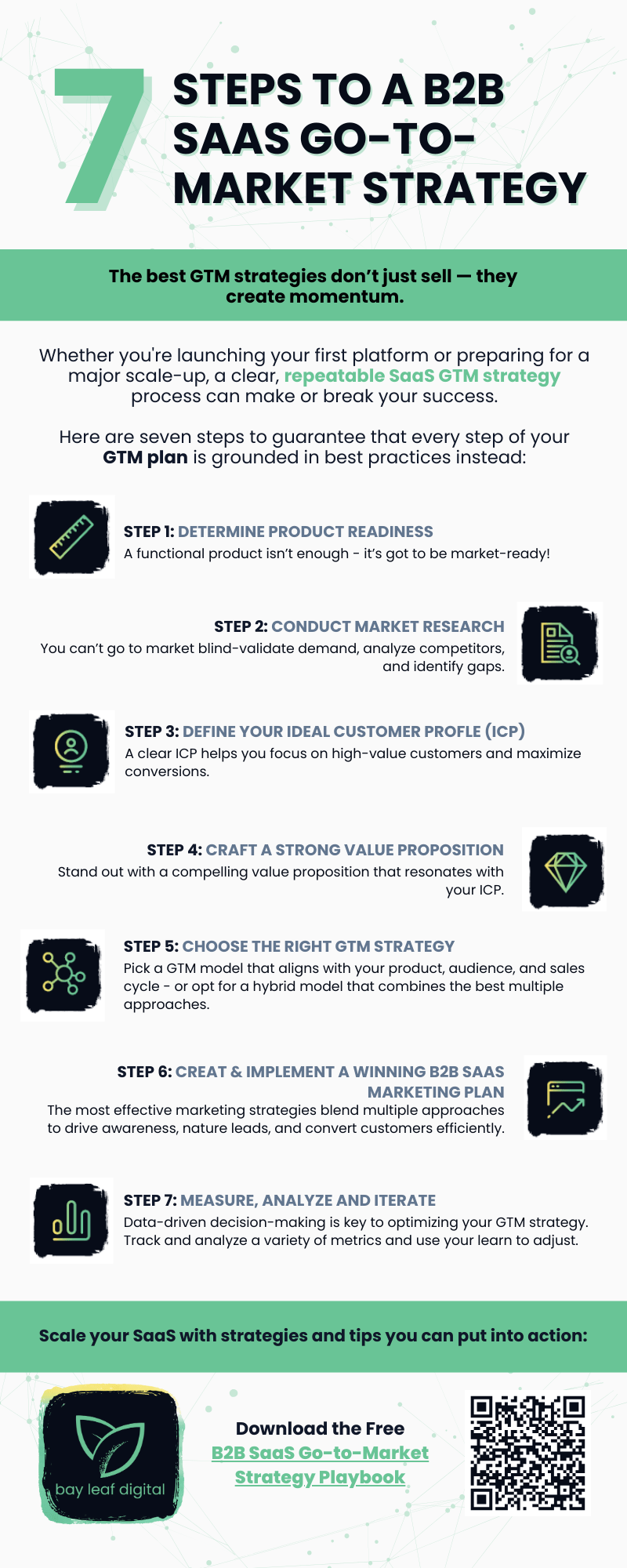Bringing a new product to market is challenging in any market. In the competitive world of B2B SaaS, it’s an especially complex and risky process. Whether you’re launching your first platform or preparing for a major scale-up, a clear, repeatable SaaS GTM strategy can make or break your success.
That’s where this quick-start checklist comes in.
Use this streamlined guide to prevent the guesswork and scattered tactics that create a chaotic launch and guarantee that every step of your GTM plan is grounded in best practices instead. Whether you’re leaning into product-led, sales-led, or marketing-led growth efforts, this mini playbook outlines exactly what it takes to bring your SaaS to market efficiently—and win.
Our 7-Step SaaS GTM Strategy
At Bay Leaf Digital, we’ve developed a 7-step plan that’s been battle-tested across dozens of successful launches. It’s designed to help SaaS companies bring their product to market with confidence, clarity, and measurable results. Each step in our process is rooted in real-world experience and tailored to the unique challenges of B2B SaaS.
If you’re looking for a SaaS GTM strategy proven to drive results, this is it.
Step 1: Determine Product Readiness
Before you invest in marketing or sales, make sure your product is truly ready for the market. You can’t go to market with a working prototype or a functional build isn’t enough. Your Minimum Viable Product (MVP) must fully solve a real, validated problem for your target audience.
This means going beyond development and involving real users early on. Recruit early adopters to test usability, stability, and your product’s core functionality. Use their feedback to refine your offering, track adoption metrics, and confirm you’re launching with something people not only need but are willing to pay for.
Product Readiness Checklist
- Ensure your Minimum Viable Product (MVP) solves a real, validated problem
- Recruit early adopters to test usability, stability, and core functionality
- Gather customer feedback and refine based on adoption metrics
Step 2: Conduct Market Research
Going to market blind risks wasting time, budget, and opportunity. Solid market research lays the foundation for a successful B2B SaaS GTM strategy by helping you validate real demand, understand where your product fits, and uncover strategic gaps in the competitive landscape.
By assessing market size, tracking industry trends, and projecting growth potential, you gain clarity on the opportunities ahead. A thorough SWOT analysis brings internal and external factors into focus, while competitor research helps you sharpen your differentiation and avoid reinventing the wheel. The insights you gather here will shape everything from your positioning to your outreach strategy.
Market Research Checklist
- Assess market size, industry trends and projected growth
- Conduct SWOT analysis to identify strengths, weaknesses, opportunities, and threats
- Research competitor offerings to sharpen differentiation
Step 3: Define Your Ideal Customer Profile (ICP)
Not every lead is a good fit, and targeting the right B2B SaaS customers is essential for efficient growth. A well-defined Ideal Customer Profile (ICP) helps you focus your marketing and sales efforts on the accounts most likely to convert, stick around, and see value in your product.
Start by narrowing in on key attributes like industry, company size, and the roles of decision-makers involved in the buying process. Then dig deeper into their pain points, goals, and buying behaviors to understand what drives their decisions. With this insight, you can craft tailored messaging for each persona, boost conversion rates, and reduce churn—all while keeping customer acquisition costs in check.
ICP Checklist
- Identify industry, company size and decision-makers
- Understand customer pain points & buying behaviors
- Create tailored messaging for different buyer personas
Step 4: Craft a Strong Value Proposition
When done right, SaaS value propositions act as the foundation of all marketing, sales, and product positioning efforts. It should make prospects stop, listen, and care by clarifying the specific outcomes your solution delivers for your Ideal Customer Profile (ICP). A strong value proposition should support your SaaS GTM strategy by clearly communicating how your solution solves a pressing problem or unlocks a key opportunity, all while standing apart from the competition. Instead of listing features, focus on benefits and real-world impact. Make sure your messaging speaks directly to customer needs, pain points, and industry trends, so it feels relevant and timely.
Value Proposition Checklist
- Focus on benefits and outcomes, not just features
- Clearly differentiate from competitors
- Align messaging with customer needs and industry trends

Step 5: Choose the Right SaaS GTM Strategy
Prioritize how your customers buy over how you want to sell when selecting a go-to-market strategy. The right model depends on your product’s complexity, your target audience, and the length of your sales cycle. For some B2B SaaS companies, a Product-Led Growth (PLG) approach makes sense—offering self-serve signups, free trials, and product virality to drive adoption. Others may benefit more from a Sales-Led Growth model, especially when selling to enterprises that require high-touch demos and longer decision-making timelines.
If you have a strong content engine or are targeting digitally savvy buyers, a Marketing-Led Growth strategy relying on inbound marketing, SEO, and demand generation can create scalable awareness and lead flow. Many successful companies use a hybrid approach, combining tactics from each model to maximize reach and efficiency.
SaaS GTM Strategy Options Checklist – Which is Right for You?
- Product-Led Growth (PLG)
- Sales-Led Growth
- Marketing-Led Growth
Step 6: Create & Implement a Winning B2B SaaS Marketing Plan
A solid B2B SaaS marketing plan is the engine behind any successful SaaS GTM strategy. To build real momentum, you need more than a single tactic—you need a mix of approaches that work together to attract, engage, and convert your ideal customers. Start by following a structured marketing funnel that guides prospects through awareness, consideration, and decision stages with purpose.
Beyond the basics, explore alternative acquisition strategies like partnerships, thought leadership, and influencer marketing to reach untapped audiences. The key is to test and refine your mix of inbound, outbound, and product-led tactics until you discover the most scalable and cost-effective path to growth. Marketing isn’t a one-size-fits-all game—it’s an ongoing process of optimization that directly.
B2B SaaS Marketing Plan Checklist
- Follow a structured marketing funnel
- Explore alternative acquisition strategies
- Combine and optimize for maximum impact
Step 7: Measure, Analyze and Iterate
Even the best SaaS GTM strategy needs fine-tuning—and that starts with measurement. Data-driven decision-making is how you uncover what’s working, what’s not, and where to pivot. By tracking key SaaS marketing metrics like Customer Acquisition Cost (CAC), you can evaluate the efficiency of your marketing spend.
Monitoring Monthly Recurring Revenue (MRR) gives you insight into predictable growth, while analyzing conversion rates helps identify which channels are driving real results. Metrics including SaaS usage rate show whether customers are engaging with your product, and tracking churn helps you flag and fix retention issues early. Analyze your data and use what you learn to iterate continuously and make smarter decisions that drive sustainable growth.
B2B SaaS Metrics to Measure and Monitor Checklist
- Customer Acquisition Cost (CAC)
- Monthly Recurring Revenue (MRR)
- Conversion Rate
- SaaS Usage Rate
- Churn Rate
A successful SaaS GTM strategy is the result of careful planning, cross-functional alignment, and consistent execution. Each of the steps in our plan works together to create a path to sustainable growth. With that launch foundation in place, you can move faster, adapt smarter, and build lasting customer relationships that drive long-term value.
Ready to scale your SaaS with a digital marketing agency that knows how to bring a new product to market? Our experts are ready to create and implement a custom SaaS GTM strategy that drives acquisition, retention, and growth for your company. Contact us today and let’s build a roadmap to success together.






